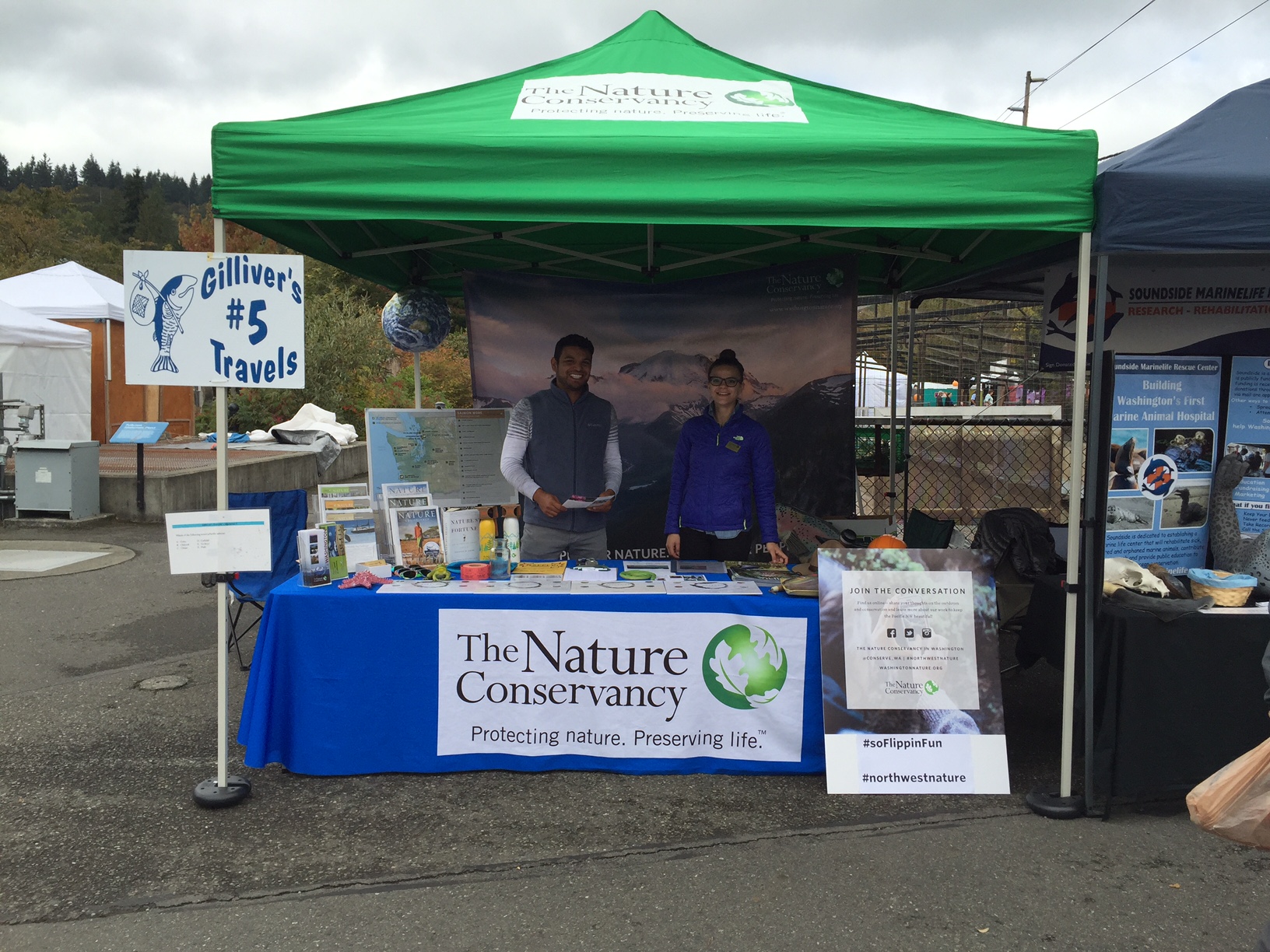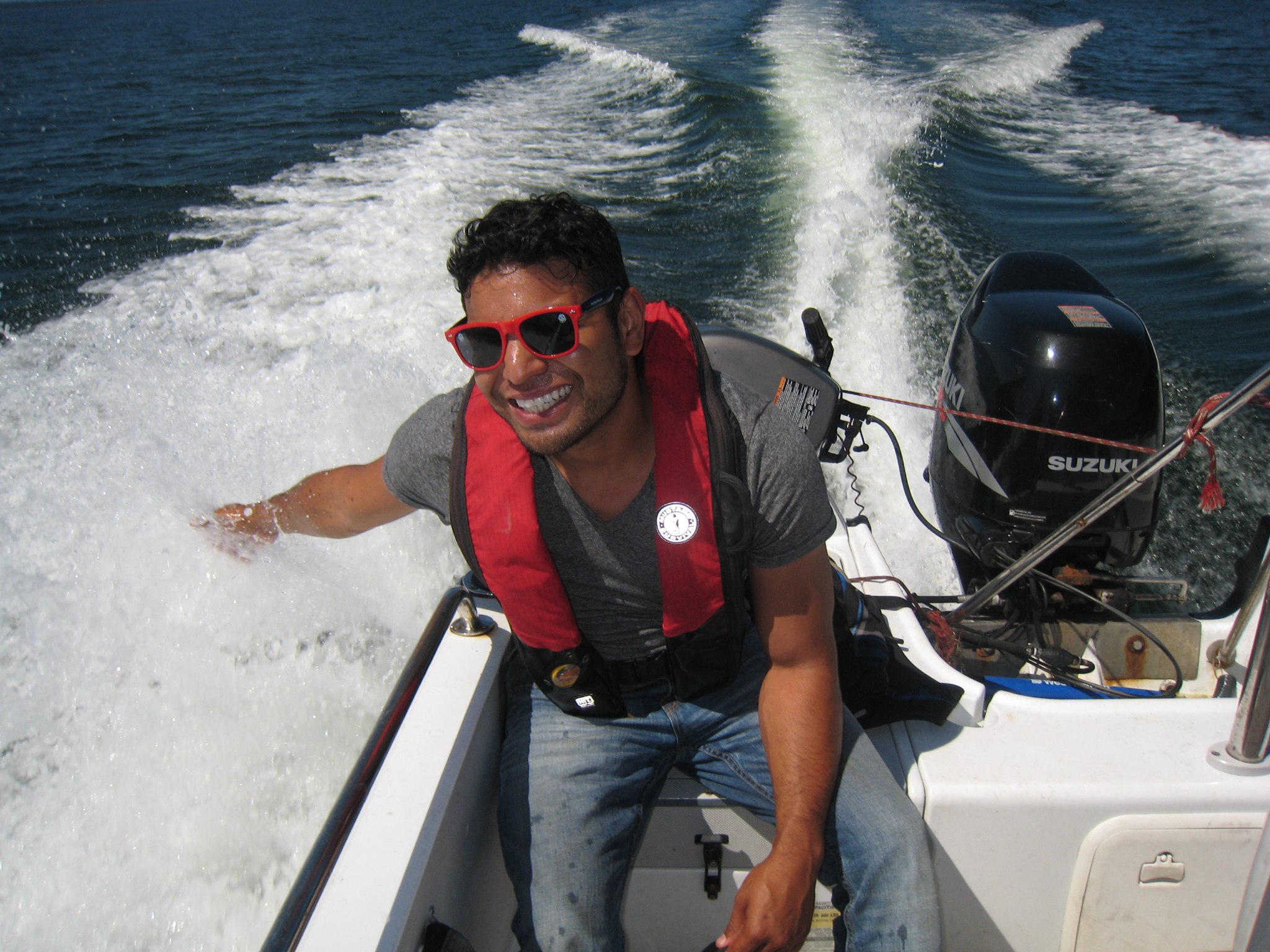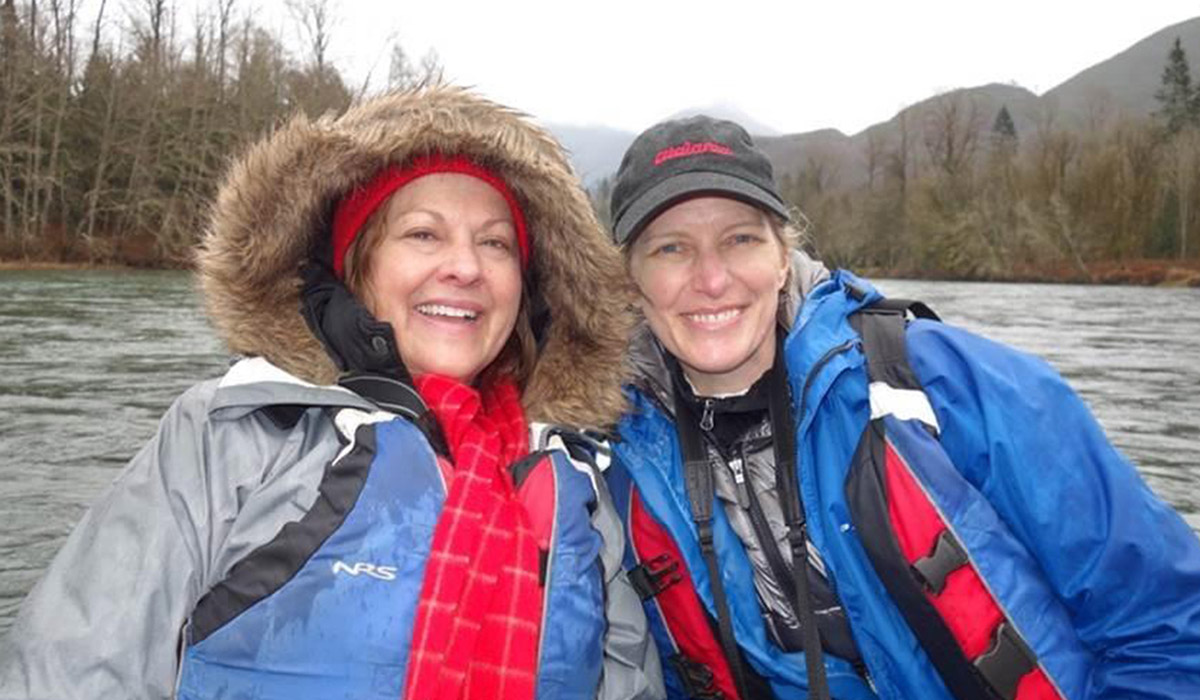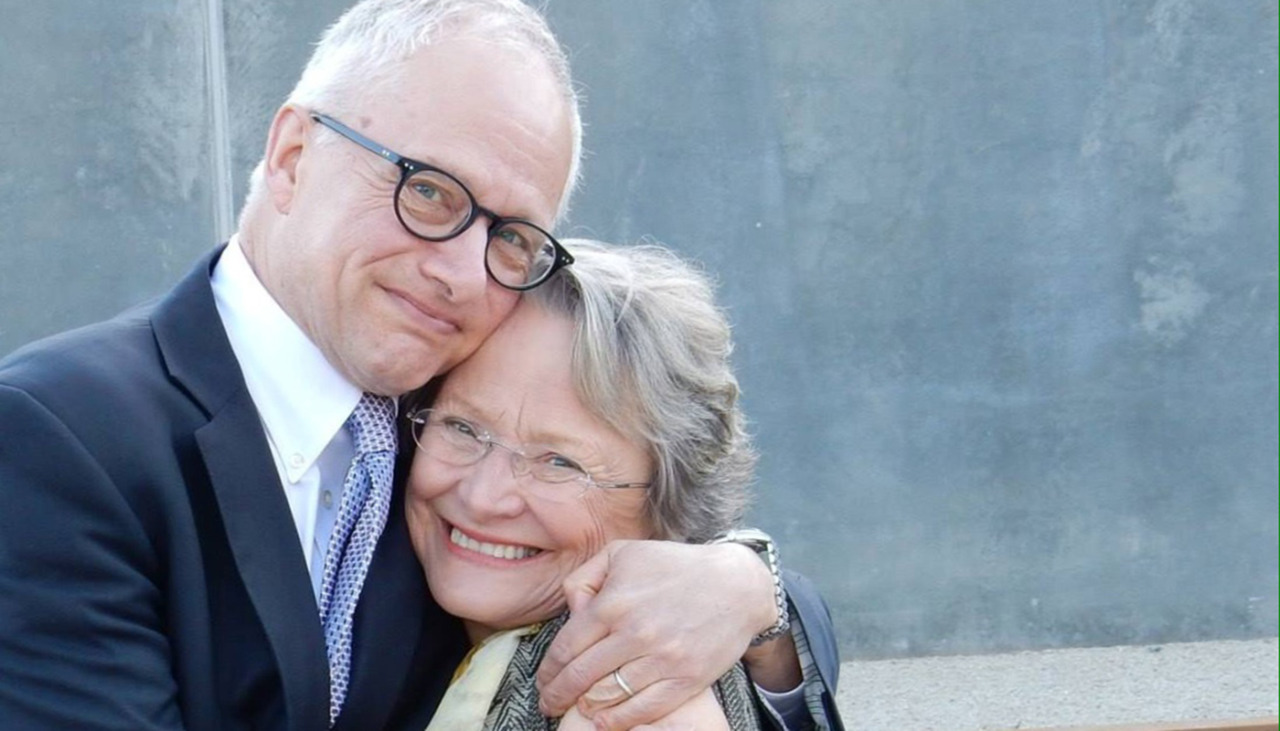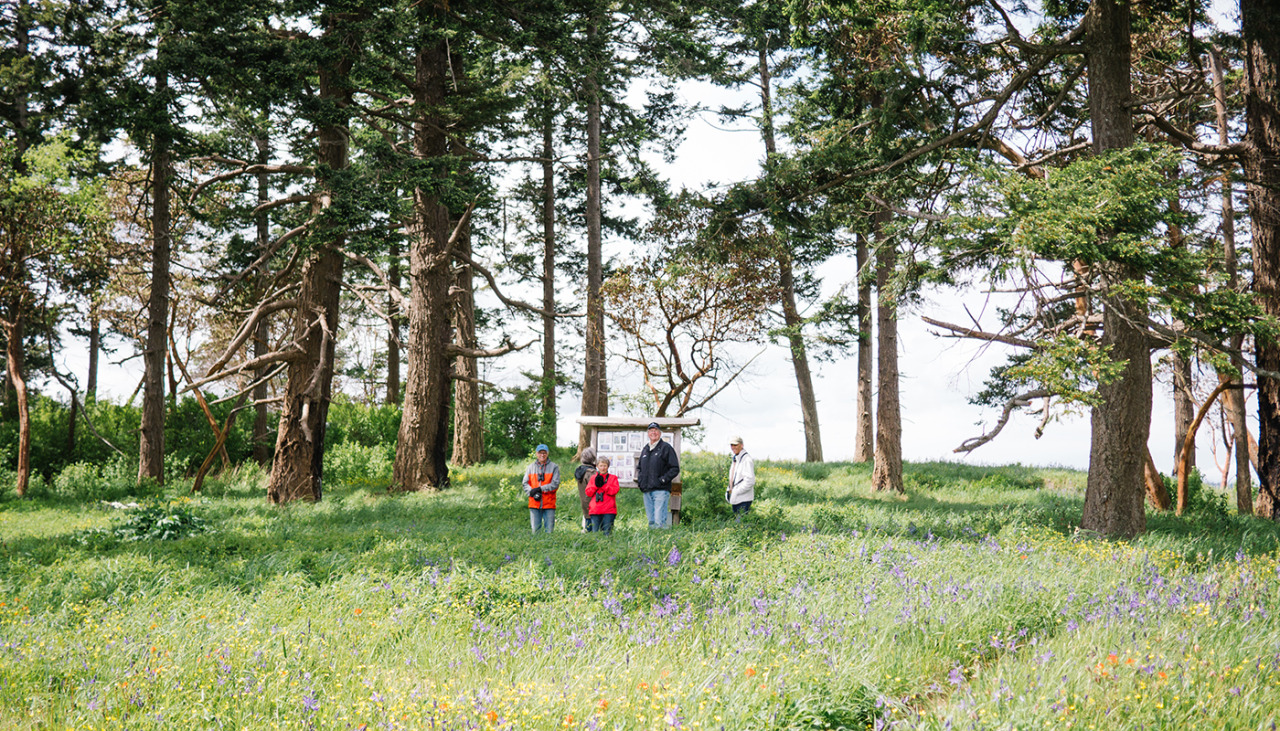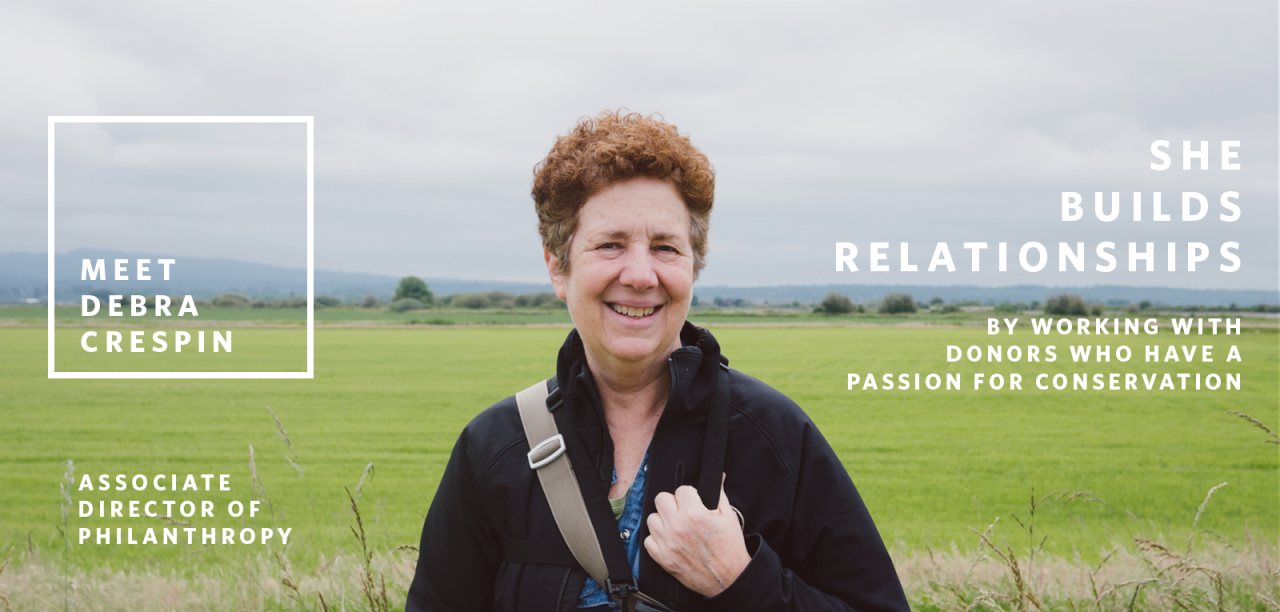We’re sharing ways to support your community as we face this challenge together.
Videos: Our Wishes for Nature in the New Year
Why I Give: Phil & Teri Martin
Phil and Teri Martin have lived in Sequim, WA since 2002. Phil is originally from Madison, Wisconsin, and Teri is from North Bend, Oregon.
“We have been members of The Nature Conservancy for about 30 years. We greatly admire the way the Conservancy works with different stakeholders to arrive at solutions, bridging differences that seem insurmountable. In 1991 we made our first trip to Africa, and simply fell in love with it, having returned eight times. It was the only place we could go and truly immerse ourselves, entirely forgetting about work or other concerns.
In 2003, we established a Charitable Remainder Unitrust for The Nature Conservancy in which we designated East Africa as the region in which the funds were to be used, even though at the time TNC had no work there, or even any plans. But to our amazement and great satisfaction, within only a year or two, TNC had undertaken a number of projects there. We were very pleased to be able to meet with David Banks and Matt Brown, Conservancy representatives in Africa, when we were in Arusha, Tanzania on our most recent trip, and to hear from them firsthand about the many projects underway.
In addition to the CRUT, The Nature Conservancy is the major beneficiary in our estate planning, and we plan, in addition to the Africa work, to support efforts in our home states of Wisconsin and Oregon, and of course, our adopted state of Washington.”
*Originally published on Leave 10
December Volunteer Spotlight: Erik Alarcon
Written by Lauren Miheli, Volunteer Coordinator
Erik has been actively involved as a volunteer with The Nature Conservancy for almost 2 years, both as a member of our Conservation Ambassadors and as a regular participant in our work parties. When he’s not volunteering with us, or working long hours with UPS, he’s an enthusiastic supporter of our work, talking about the importance of conservation to anyone who will listen. We appreciate Erik for his willingness to always help out with the heavy lifting, and for always making volunteering fun! Thank you Erik!
Recently we chatted with Erik about why he volunteers, and what matters most in life. Here’s what he had to say.
The Nature Conservancy: Where are you from? How long have you been living in Seattle?
Erik Alarcon: I was born in Chicago, grew up in Los Angeles, and went to college in Arizona. I have been living in Seattle for about 3 years. I love Seattle. One of the main reasons I’ve stayed here is for the outdoor activities!
TNC: What inspired you to start volunteering with The Nature Conservancy?
EA: I love the outdoors! I first signed up with Washington Trails Association clearing trails, but most of their opportunities did not fit with my schedule. I was headed home from hiking one day, and I saw a volunteer recruitment flyer at a Starbucks, which led me to call and sign up. It’s actually a funny story… I almost didn’t come back after my first time volunteering. The Volunteer Coordinator (Lauren) chastised me for not wearing my logo t-shirt to the event. But I kept getting the emails and ended up coming back and having a great time (and Lauren calmed down about the t-shirt thing.)
TNC: What gives you the most hope for the future?
EA: People are having more awareness of climate change and that we need to preserve our wilderness and nature. We know that we need to take care of the beauty around us. Washington is a beautiful place that we want to be able to share with our kids and grandkids, and teach them to appreciate and take care of the environment.
TNC: How does volunteering make you feel?
EA: Good, like I’m helping out. It makes me feel a part of something. It makes me feel like I saved bunnies*. Volunteering helps you learn things that you never would have learned yourself; there’s a lot of history in Washington. You get to meet new people. There are interesting people from different walks of life. Everyone I’ve met through The Nature Conservancy is selfless, so kind and giving. Also, there are always good snacks and refreshments for volunteers!
*(Editor’s note: Erik volunteered with the Pygmy Rabbit Reintroduction Project in partnership with the Department of Fish and Wildlife, so he literally did save bunnies.)
TNC: What is your favorite Nature Conservancy preserve or project?
EA: The Moses Coulee and Beezley Hills Preserves, and the Pygmy Rabbit Reintroduction Project! I volunteered twice on this project already, and am looking forward to getting out there again soon.
TNC: What do you think the world will be like in 50 years?
EA: I think we’re going to be fine. I think a lot of people are realizing we can’t continue to take the resources of our planet, and we need to conserve the environment.
TNC: Have you ever convinced someone to do something they didn't want to do?
EA: Yes! When I first moved to Seattle I was amazed that many of the people who I met who grew up here had never left the city, so I coordinated hiking trips to get them outdoors and show them the beautiful nature they had been missing out on. Hiking can be intimidating when you think you need expensive hiking boots and special gear, or that you need to be “outdoorsy”, but really anyone can get out and enjoy the wilderness, you really don’t need much more than a map, food, water, and good friends to hike with!
Why I Give
Written by Noelle van der Straaten, Volunteer Writer
Photographs by Beth Glosten
Beth Glosten, MD, retired from medical practice, runs her own business, RiderPilates, LLC where she teaches mindful pilates-based movement classes, and horseback riding lessons focusing on rider biomechanics. Beth is a Seattle area native, but has lived in several different areas of the U.S. However, the beauty and opportunities of the Pacific Northwest eventually drew her back and she has lived in Redmond, with her horses and cats, since 1992. She enjoys hiking and beach walking, as well as growing vegetables, playing in the kitchen, and cooking for friends.
We interviewed Dr. Glosten about what inspires her to give back to nature:
Tell us about your favorite memory or experience in nature?
I’ve had many! I feel very fortunate to be able to choose among my experiences in nature. I travelled to southeast Alaska and took a trip on a float plane to a river delta when the salmon were running. We watched bears that were so engrossed catching them for food. I was part of a group, with a guide, hunkered down near a river and watching the bears catching and eating salmon. It was a thrilling experience.
Why is nature important to you?
I see nature as a way for us to find balance and as we mostly live in populated areas, I believe it helps balance out our lives. The sounds in nature are different and being in nature helps me appreciate the different systems in the world. It is very humbling being out in nature.
Why do you choose to give to The Nature Conservancy?
I believe in the Conservancy’s mission and the method of your mission. The Conservancy’s way of supporting a threatened ecosystem that is based on science and finding options for both economies and nature to thrive together, is a good method.
I was involved in a Conservancy project– “Farming for Wildlife” – that I very much enjoyed. This program is a great example of how TNC brings all parties to the table and has farmers thrive alongside migrating shorebirds. Watching the plans of this project evolve solidified my support of TNC and their work.
November Volunteer Spotlight: Caitlyn O'Connor
Despite having only been actively volunteering with us for three months, Caitlyn has made a strong impression on our staff and board of trustees. She is often still in the office working on her projects after all staff members have gone home. We'd like to acknowledge her willingness to jump right in and work hard by recognizing her with November's Volunteer Spotlight! Nice work Caitlyn!
Caitlyn is our Volunteer Trustee Coordinator, and is also assisting our Puget Sound Program Director Jessie Israel with social science research that connects the dots between investments in natural infrastructure and its impacts on people, economy and our communities. A West Coast native, Caitlyn grew up in Los Angeles, went to school in Victoria, Canada, worked for a start-up in San Francisco and is currently in Seattle pursuing her dream of working with a non-profit to make a difference in the community. She moved to Seattle in April and has been in love ever since.
At the University of Victoria, she co-founded BOSS (Sociology Student Society) and was a research assistant for Dr. Vahabzadeh while he was studying the power of social movements and the influence they have on individuals to be active or passive in the transition.
We asked Caitlyn to tell us about why she volunteers with The Nature Conservancy and is passionate about nature, and here's what she had to say:
The Nature Conservancy: What inspired you to start volunteering with The Nature Conservancy?
Caitlyn O'Connor: I want to work for TNC because their values align with mine. They are science-driven, hold deep experience and have proven results across the globe. They care about our rapidly changing climate which is straining our natural systems on which all life depends.
TNC: What gives you the most hope for the future?
CO: People, our ability to make a difference, that we can come together and collaborate to advance a movement.
TNC: What's your favorite thing to do when you're not volunteering?
CO: Plan my next adventure, which is currently Iceland, and drink coffee; preferably at the same time.
TNC: How does volunteering make you feel?
CO: It feels great to be around people with similar interest, to help others and enact change. It gives me a sense of pride and identity of doing good and helping others. It gives me a positive view of my life and my future goals.
TNC: What is your favorite Nature Conservancy preserve or project?
CO: My favorite project is Cities. Making it possible for nature and cities to coexist through the development of green infrastructure and natural solutions to pollution.
TNC: What do you think the world will be like in 50 years?
CO: I don't know since Back to the Future is now completely in the past.
TNC: Who is your environmental hero?
CO: Each and every one of us who does their best to protect our planet.
TNC: What is your spirit animal and why?
CO: I am a butterfly, owl, and tiger according to this survey. The butterfly is a symbol of powerful transformations and currently, I have changed my location and direction of my career. The owl is about seeing beyond the veil of deception and illusion, solving mysteries of life. My favorite thing about Sociology is researching and presenting the "hypocrisy" of our society. And lastly, to move cities, change careers, and investigate the hidden, the spirit of a tiger – willpower, personal strength, and courage – polishes off my personality. So yup, I think this quiz is fairly accurate.
TNC: Have you ever convinced someone to do something they didn't want to do?
CO: Yes, but most of the time it is for their/our good. When I was 18, my best friend and I decided to travel Europe, London to Rome, with no itinerary and no hostel booked for the six weeks. Let's say, the stories started on our first night. We almost slept on a bench because every hostel was booked for Wimbledon. Oooops.
TNC: Is there anything you would like to see The Nature Conservancy doing that we are not already doing?
CO: I would like to see The Nature Conservancy demand more from the government to enact change.
BE THE CHANGE. SIGN UP TO VOLUNTEER TODAY.
Meet our amazing Director of Philanthropy, Mary Kaufman-Cranney!
The 2015 Professional Achievement Award winner!
Written by Meghan Wagner, Associate Director of Philanthropy
We have amazing colleagues here at The Nature Conservancy and are so proud to honor one of our very own, Mary Kaufman-Cranney, Director of Philanthropy for our Washington Program. Mary brings energy, excitement and leadership to our Philanthropy team and most importantly, her work brings support and critical funding to our large-scale conservation projects both locally and globally. It was announced today that Mary is the winner of the prestigious 2015 Professional Achievement Award through AFP Advancement Northwest.
Mary joins a select group of Northwest leaders who have made a big impact in the social sector through fundraising and storytelling. She shares a deep commitment to mentoring others, is the embodiment of integrity, professionalism and excellence and is a Philanthropy superstar!
Mary’s leadership has spanned more than 25 years in our Seattle community. She is passionate about making an impact in our community through cause-driven organizations. She directed three major capital campaigns and secured over $60 million for youth development initiatives while the Senior Vice President of Financial Development at the YMCA of Greater Seattle.
Mary joined The Nature Conservancy in Washington in 2010 and has reinvigorated funding impact for critical conservation projects. Fundraising, at its core, is connecting people to the mission by first learning what ignites the passion in their hearts and then connecting those values to the impact they could make in the community. Mary helps donor visualize their values in action through her authenticity, and unwavering belief in the work of The Nature Conservancy’s mission. One of her great strengths is relationship building with board leaders, volunteers and our staff teams.
As a lifelong resident of Washington State, Mary has a strong connection to our lands and waters. Some of her most cherished and beloved memories are time spent with her family in nature or at her favorite lake cabin. She has experienced firsthand how nature can inspire and enrich lives and she brings that level of dedication and passion to the mission of The Nature Conservancy.
Through her work at the Conservancy, she has traveled to Africa, Mexico, Great Sand dunes of Colorado, Alaska, and beyond. Whether she is helping with a science observation project tracking alligators in Mexico or staying in yurts in the African safari, Mary’s passion for her work comes through seeing the projects firsthand.
Please join us in congratulating Mary on this well-deserved recognition for her impact in our community!
2014: Huge Progress for Nature and People
2014 was a year of unprecedented progress for The Nature Conservancy in Washington. Thanks to your strong support we were able to do more for people and nature than ever before. Here are some of the highlights as reported in the news media:
Top Stories of the Year Lists
- Number 8 on Top Story of the Year. Ellensburg Daily Record
- Number 8 on Top 10 reasons to be encouraged by environmental progress in 2014. The Huffington Post
- One of the Top Outdoor Stories of the Year. The Spokesman Review
Protecting, connecting and restoring forests
- 48,000 acres of prized forestland acquired for people and nature. Seattle Times
- 2500 acres on Clearwater to be acquired, restored for Salmon. Seattle PI
- Report offers forest restoration needs. The Spokesman Review
- Manastash acquisition protects wildlife. Yakima Herald
- Queets land to be protected. KONP
- Forests play critical role in drought resiliency. Crosscut
Protecting communities from catastrophic fire
- Managing forests for resilience. Yakima Herald
- Wildfires, climate change,restoration. Seattle Times
- The science of controlled burns. Yakima Herald
Protecting nature and communities from flooding
- Communities work with nature to reduce flood risks. The Columbian and more than 30 other outlets
- Orting levee successful. KOMO-TV
Raising voices and money for nature
- Illabot Creek designated wild and scenic. Skagit Valley Herald
- Record breaking donation connects local and global work. Seattle Times
- Farm bill to help conservation. NorthWest Public Radio, including KUOW
- Bill Robinson, nature’s voice in Olympia. The Olympian
Innovative science
- Quinault Indian Nation neutralizing derelict crab pots. The Daily World
- Salmon recovery in Fisher Slough. Skagit Herald
- Science at work in Moses Coulee. Seattle Times
- Bat survey. KUOW
- Using quadcopters for conservation. KIMA-TV, KUOW
Washington Trustee John Rose receives Oak Leaf Award
Champion for Eastern Washington Forests and Conservation across the state
John Rose is passionate about Washington’s great outdoors. It’s a passion that he has carried his whole life, has fostered in his family, and celebrates with his friends. The Evergreen State’s signature landscapes have been the backdrop for some of the most exciting and momentous times in John’s life – from childhood trips in the San Juan Islands, to exploring forests of the Cascades, to courting his wife, Patty in the fragrant sage desert of central Washington. John cares about maintaining our state’s beauty and health for all who live here. But there is one thing that John cares about even more than the great places of Washington and the Northwest- conserving those places for future generations.
John’s commitment to conservation here and around the world was honored this week at a global gathering of trustees where John was recognized with the Oak Leaf Award for his tireless leadership and hard work.
A member of The Nature Conservancy since 1975, John has served on the Board of Trustees of the Washington Chapter since 2000. During that time, has been Board Chair as well as chaired the Board’s Philanthropy, Nominating & Governance, Executive, Campaign and Conservations Committees.
John is a leader amongst our trustees and an anchor of the Board. He has a deep understanding of the Conservancy’s work and is relied upon by his fellow trustees to bring a balanced, insightful and probing perspective to our work. He deeply supports the staff. He works indefatigably on our behalf. He has an infectious passion for our work and the people with whom we work. And he has backed up his passion and his work with major philanthropic commitments.
A thought leader for the Conservancy, John has led the Board in moving from a preserve and Washington focus to an embrace of our global mission and the role of the Chapter in advancing our Global Challenges/Global Solutions approach. He has traveled to Central America and across the Pacific Northwest and Canada to learn about our work. He has galvanized Board support and engagement in our next-generation projects such as marine fisheries conservation and the Emerald Edge as well as large-scale forest conservation and restoration in the Cascades.
John’s tangible, lasting contributions to our mission, to the region and to the Chapter are extraordinary. John has demonstrated a remarkable ability to inspire giving in others. John is the kind of trustee that enables us to change the world.
It is a sign of John and his wife Patty’s exemplary leadership and their deep commitment that receiving the Oak Leaf Award is not only a highlight for them, but also a moving and joyous moment for all of us at the Washington Chapter.
Meet Debra Crespin!
Our fantastic Associate Director of Philanthropy!
Deb was born in the Bronx, but grew up in the suburbs of California. Eventually she escaped to Northern California before moving to Vermont and now Seattle! That’s a lot of traveling, something she loves to do!
If you could live anywhere, where would it be?
I’d split my time: a few months on San Juan Island, a few months in rural Vermont, and the rest in Seattle. Then, of course, I’d travel a lot – everywhere else!
What is your favorite part of nature?
I love forests and high mountain landscapes.
Favorite hobby?
Birding
Favorite food?
Anything Mexican
In one simple and plain sentence, what do you do?
I build relationships with donors who have a passion for conservation, connecting them to our work, and working to secure their philanthropic investment.
Meet Meghan Wagner
She’s our Campaign Manager who inspires others to transform nature through the power of giving. Read her story:
As a lifelong resident of WA state, I am passionate about the outdoors. My most cherished and beloved memories are with my family learning and exploring the water and land of our beautiful local natural resources. At an early age, I was taught that our collective future is intrinsically linked with the ways we respect and protect nature, and I have been a committed advocate in both my personal and volunteer pursuits to this cause.
I have experienced firsthand how nature can inspire and enrich lives and I bring this level of dedication and passion to the mission of The Nature Conservancy.
This is a quote from my good friend, Sarah Brooks (Associate Director, Methow Conservancy):
“I believe, deep in my soul, that one of the most noble and amazing things you can do in your life is to find a cause you care deeply about and invite others to join you in transforming the world. I believe asking – fundraising – is an incredible privilege.
I believe asking others to give is like being a really good matchmaker – you have the rare opportunity to give another person a chance to express what they value by giving to a cause that will make life better. That moment – when a person realizes they can make a difference – is magic and to be a catalyst of that is nothing short of stunning. Done with joy, respect, and humility, “asking” can be one of the most meaningful and powerful things you will ever do.”
Conserving Manastash Forest For Wildlife, Water and People
More streams for fish, hiking trails for people and habitat for wildlife. That is just some of what we are getting after the newest purchase of land for people and nature .
The latest addition to the Heart of the Cascades project is 1,280 acres of timberland in the Manastash, west of Ellensburg. The decade-long effort to weave together a checkerbaordof public and private lands in the East Cascades takes another step forward, adding to more than 25,000 acres of private timberlands brought into public ownership.
In this case, The Nature Conservancy has purchased 1,280 acres of timberland from Plum Creek, and transferred it to the Washington Department of Fish and Wildlife to be managed as part of the L.T. Murray Wildlife Area.
Working with partners including the Department of Fish and Wildlife, the Yakama Nation and Rocky Mountain Elk Foundation, the Conservancy continues to secure public access and protect this vital resource for our communities. The Tapash Sustainable Forests Collaborative, which includes public, non-profit and tribal landowners, is working together across in this region to restore a much larger forest landscape.
Water for the Future
Why does it matter? These particular sections of forest are full of streams and tributaries that flow into the Yakima River. Conserving this forest will protect valuable river habitat for wildlife as well as ensure water downstream for people, fish, and the rich agriculture of the Yakima Valley. Protecting these forests is an important part of the Yakima River Basin Integrated Plan, a coordinated effort by farmers, conservationists, tribes, and governments to ensure water for the Yakima Valley as climate change threatens increasing drought.
Rich Wildlife Habitat
Washington’s Heart of the Cascades is a multi-phased project designed to protect, connect, and restore the most biologically rich forests in the Western United States.
From high mountain snowfields descending to the arid sagebrush steppe of the Columbia Plateau, the Cascade forests span rugged and beautiful country that supports a diverse variety of habitats and, in turn, a broad array of species. In addition to amazing abundance of birds, mammals, fish, trees, and flowers, these forests are home to federally protected populations of grey wolf, spotted owl, ferruginous hawk, northern goshawk, and Pacific salmon. People across the region prize these forests for their many recreational activities.
Your Support will Help Save Forests for Nature and People
Today, we have a remarkable opportunity to invest in the future of this place and to protect what we love about it – lush alpine meadows, clean cold mountain streams, and the unfettered access that comes with a connected and protected landscape. We have this opportunity because tens of thousands of acres of private commercial timberlands are for sale. These lands, privatized in the 1800s to bring the railroads to the Pacific, disconnect our federal forestlands from our state Wildlife Areas. Their sale to development threatens access and opportunity for people and wildlife on this landscape.
The Heart of the Cascades project is a cooperative effort by conservation groups, tribes, residents, and public land management agencies to accomplish the following:
- Protect 110,000+ acres of forests that will reconnect a four million acre landscape
- Protect access and open space for people and wildlife
- Restore the natural functions and processes that sustain these forests, including reintroducing beneficial fire and restorative thinning where needed
- Support local economies working in a compatible way with the natural resources and values of the region
WASHINGTON LEGACY CLUB VISITS THE EMERALD EDGE
For thousands of years, indigenous people have plied the marine waters of the northwest coast of North America, trading, hunting, sharing knowledge and cultures. In this region, people, salmon, oceans and forests are intertwined across political borders. Conservation work must be interconnected as well.
The Nature Conservancy has launched a new international program, Emerald Edge, to work with First Nations and local communities to protect habitat, restore forests and build sustainable economies across the world’s largest temperate rainforest, the 70 million acres stretching from Washington through British Columbia and into Southeast Alaska.
Paul Dye, Marine Director for The Nature Conservancy in Washington, shared stories and photos from the Conservancy’s work in the Emerald Edge with members of Washington’s Legacy Club at a special lunch on June 19.
Legacy Club members are those Nature Conservancy supporters who have chosen to make a lasting commitment to conservation by naming the Conservancy as a beneficiary in their estate plans, or by making a life income gift to the Conservancy. The Legacy Club is a way for us to recognize this profound contribution to The Nature Conservancy’s future. Members have the opportunity to meet Conservancy scientists and conservation practitioners, and get an inside view of the conservation work that is enabled by their generosity.
We thank our Legacy Club members for their dedication to preserving the diversity of life and for their foresight in providing for its future.
To learn more about the Legacy Club, contact Daniel Hoon, (206)436-6262, or dhoon@tnc.org.
NATURE CONSERVANCY RAISES $33.3 MILLION FOR CONSERVATION
Private donations transform work to restore natural systems in Washington and around the world
SEATTLE: The Nature Conservancy’s three-year Forces of Nature campaign has raised $33.3 million in private dollars for conservation in Washington and internationally. The campaign, the largest in the chapter’s history and one of the largest campaigns for conservation ever in Washington, was focused on conserving and restoring natural systems while enhancing the well-being of people.
“Our economy and quality of life are intertwined with our state’s clean water, abundant natural resources and astounding beauty,” said Mike Stevens, the Conservancy’s Washington director. “Through their generosity to this campaign, the people of Washington have shown they understand and value what we have and are willing to work to steward it.”
“We are grateful to our donors who have demonstrated their passion and commitment to conservation even during difficult economic times,” said Campaign Chair Elaine French, a volunteer and member of the state chapter’s board of trustees.
In all, the Conservancy raised nearly $18 million for acquisitions, $10 million for on-the-ground work, and more than $6 million for international programs.
Funds raised through the Forces of Nature Campaign are already bringing results.
- Puget Sound: Partnership-driven, high-impact projects are blending flood protection, salmon habitat, stormwater reduction and agricultural preservation across more than 1,000 acres of floodplains along eight major rivers.
- East Cascade Forests: Critical timberlands have been brought into public ownership and we are partnering to restore forests to reduce the risks of catastrophic megafires, while promoting ways to ensure the economic viability of forest-dependent communities.
- Olympic Rainforest: We are working hand in hand with coastal communities to conserve and restore forests along our most important coast salmon rivers.
- Marine Waters: A new program focuses on conserving Washington’s 28,000 square miles of marine waters and fisheries in Puget Sound and off the coast.
- Emerald Edge: A new international program conserves habitat, restores forests and fisheries and builds sustainable economies across 70 million acres in the world’s largest temperate rainforest, stretching from the Washington coast through British Columbia and into Southeast Alaska.
- International: Support from Washington allows Conservancy programs around the world to benefit nature and people, for example protecting elephant habitat in Africa through indigenous communities.
Forty-five donors gave gifts of $100,000 or more. The campaign was also supported by corporations and private foundations, including Boeing, Harriet Bullit’s Icicle Fund, and the Paul G. Allen Family Foundation.
“What makes this campaign so special is our work with people—farmers, fishermen, loggers, business owners, tribal communities—to develop projects that will have the biggest impact on people’s lives and on our future,” said Mary Ruckelshaus, chair of the chapter’s board of trustees. “Using innovative, science-based solutions, we are making life better for people and communities while protecting the natural resources on which we all depend.”
Contact information
Robin Stanton
The Nature Conservancy
(206) 436-6274
rstanton@tnc.org









